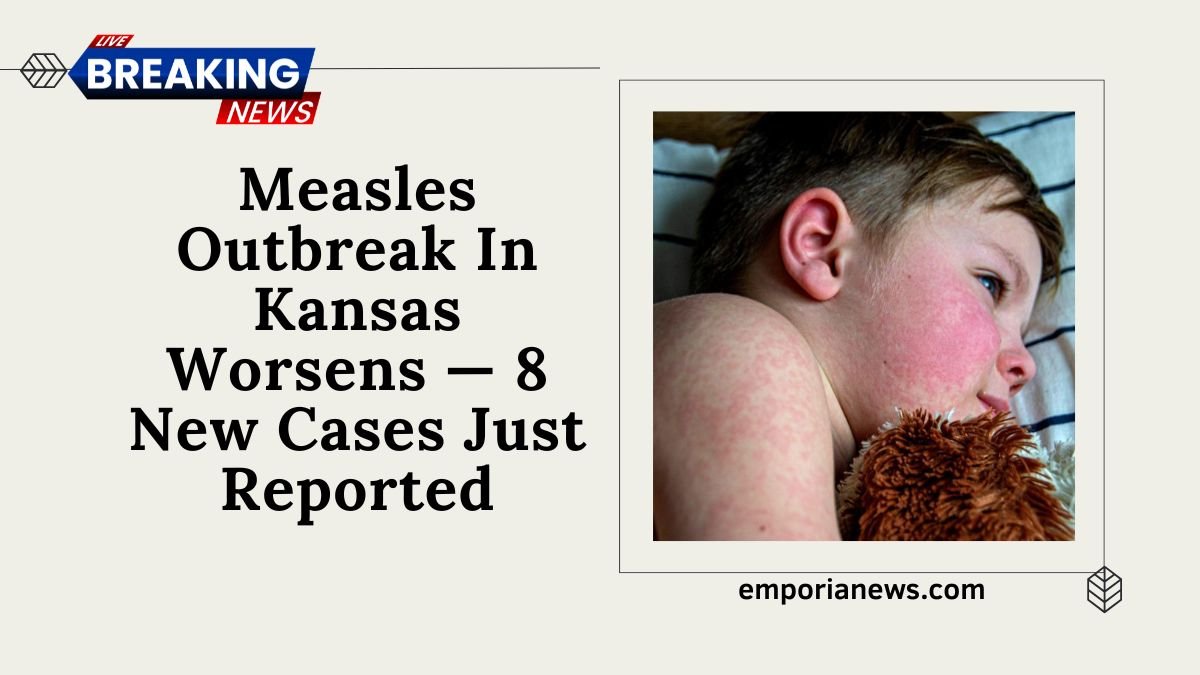The measles outbreak in Kansas continues to escalate, with eight new cases reported by the Kansas Department of Health and Environment (KDHE) as of May 28, 2025.
The state now faces a total of 64 confirmed measles cases, marking one of the largest localized outbreaks in the United States this year.
While health officials work to contain the spread, Gray County in southwestern Kansas has become the epicenter.
This recent surge is part of a broader uptick in measles cases across the country, with the CDC confirming 1,088 cases nationwide, up 42 from the previous week.
Kansas Measles Outbreak 2025: Key Numbers
As of the latest update:
- Total measles cases in Kansas: 64
- New cases reported since May 14: 8
- Counties affected: 11 (primarily in Southwest Kansas)
- Hospitalizations: 2
- Outbreak-linked cases: 59 of 64
The majority of cases in Kansas are linked to a single outbreak cluster, indicating ongoing transmission within certain communities.
Breakdown of Kansas Measles Cases
| Metric | Value |
|---|---|
| Total confirmed cases | 64 |
| New cases (as of May 28) | 8 |
| Primary outbreak cases | 59 |
| Counties involved | 11 |
| Hospitalizations | 2 |
| Worst-affected county | Gray County |
Why Gray County Is the Focal Point
Gray County, located in southwest Kansas, has seen the highest number of cases in this outbreak. The local transmission rate suggests low vaccination coverage in some parts of the community.
Health officials are urging residents to verify their immunization records and receive the MMR vaccine (measles, mumps, and rubella) if they haven’t already.
KDHE has initiated contact tracing, vaccination drives, and public health advisories to contain the virus’s spread.
U.S. Measles Cases on the Rise
This Kansas outbreak is not isolated. Measles cases are increasing across the country, with the CDC reporting 1,088 confirmed cases nationwide, an increase of 42 cases from the previous week.
States like Colorado have also reported fresh outbreaks, suggesting a trend of regional clusters. Public health experts warn that unvaccinated individuals are at the highest risk, especially children under 5 and immunocompromised adults.
What Makes This Outbreak Concerning?
- High transmission rate: Measles is among the most contagious diseases, with a 90% transmission rate among unvaccinated individuals.
- Community spread: The fact that most cases are linked indicates the virus is actively circulating in public settings.
- Low vaccine uptake: Outbreaks often occur in communities where MMR vaccine rates fall below the 95% threshold needed for herd immunity.
- Hospitalization risks: Though only 2 cases have been hospitalized, severe complications from measles can include pneumonia, encephalitis, and even death.
What You Need to Know About the Measles Vaccine
The MMR vaccine is the best protection against measles. It is 97% effective when two doses are administered. The CDC recommends:
- First dose at 12–15 months of age
- Second dose at 4–6 years of age
Adults born after 1957 should confirm their vaccination status or immunity, especially if traveling or in close-contact environments like schools or hospitals.
Public Health Response in Kansas
Kansas health authorities have ramped up the following measures:
- Vaccination campaigns in affected counties
- Public awareness announcements through schools, clinics, and media
- Testing and isolation protocols for suspected cases
- Contact tracing to prevent further spread
The KDHE urges residents across Kansas to stay alert, especially in Gray County and surrounding regions.
The worsening measles outbreak in Kansas—with 64 confirmed cases across 11 counties and Gray County at the center—is a reminder of how quickly this preventable disease can spread. With 8 new cases added in just under two weeks, the urgency to act is clear.
Public health officials continue to emphasize the importance of vaccination, early detection, and community awareness. As national case numbers rise, Kansas remains a key area of concern in the ongoing fight to contain measles in 2025.




